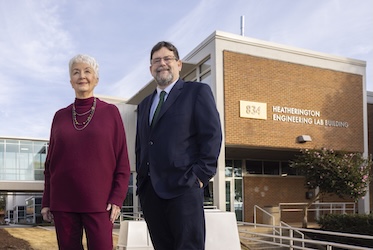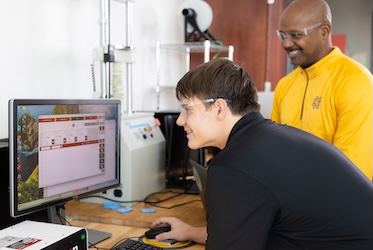

KENNESAW, Ga. | Oct 27, 2017
Students showcase engineering prowess in annual Pumpkin Launch
Hours before the seventh annual Pumpkin Launch, seven Kennesaw State University students walked their wooden-framed launcher onto the field between Howell and Norton halls on the Marietta Campus. For the last two weeks, their lives had been consumed by building a device capable of lobbing a pumpkin nearly 100 feet.
The KJC Bouncers, as they called themselves, were one of 29 teams competing in Thursday’s launch on the Marietta Campus. The event featured more than 240 first-year mechanical engineering students attempting to lob a pumpkin the closest to a 30-centimeter (12-inch) target 30 meters (98 feet) away using an apparatus of their own design and engineering.
Under competition rules, their launchers had to be “purely mechanical,” meaning they could not use chemical propellants or electrical power. They must fit in a space 8 feet long, 8 feet wide and 6 feet high, with a maximum counterweight of 500 pounds. Each team is allowed three attempts to launch a pumpkin in a positive direction, and awards are given for distance, accuracy and pumpkin decoration.

The pumpkin-launching tradition began when then-Southern Polytechnic State University looked for ways to develop an interesting experience for first-year students and to help with student retention, said David Veazie, professor of mechanical engineering. The launch is the culmination of a semester-long project for students in the Introduction to Mechanical Engineering course offered by the Southern Polytechnic College of Engineering and Engineering Technology.
“This is a course that will give students a taste of what goes into engineering design,” Veazie said. “There are a lot of courses students have not taken at this point: physics, calculus or machine design. In lieu of that, we teach the students projectile motion and stress analysis so that they have enough of a taste to enjoy designing a structure that can hurl a pumpkin as far as possible.”
The launches don’t always go as planned. When the KJC Bouncers got the go-ahead at the competition, team captain Nick Weaver yanked the trigger pin using a 6-foot rope and stepped back as the counterweight dropped, causing the projectile arm to fling forward. The pumpkin cleared the sidewalk in front of the launcher but only rolled to about 15 feet on its first attempt.
Their research and calculations had the pumpkin flying at least 100 feet.
Two weeks before the launch, teams were subject to a critical design review, which amounts to a classroom presentation in which they defend the merits of their design and the research that went into its selection.
The KJC Bouncers explored five designs as part of its review: the traditional trebuchet, the ballista, the torsion catapult, the centrifugal trebuchet and the floating arm trebuchet. In addition to Weaver, team members included Zac Hedrick, Jacob Larson, Dean Bickham, David Schoessler, Andrew Webb and Daryl Diaz-Rodriguez.

Team members explained the pros and cons of each design to their classmates. The traditional trebuchet, though safe, had poor energy transfer. The ballista and torsion catapult were both cost efficient but were deemed unsafe. The centrifugal trebuchet had the cool factor, but also had a very complex design with too many variables for their calculations. Placing an emphasis on reliability, the KJC Bouncers settled on the floating-arm trebuchet.
The design features a vertical “drop channel” down the center of the trebuchet. When triggered, gravity pulls a weighted bar downward, dragging the arm of the trebuchet forward along a horizontal guided track and launching the pumpkin downrange. The intricate design also features two pivot points that make it more efficient than the other researched designs.
Based on calculations for stress analyses on the arm and the projectile distance, the KJC Bouncers gave their invention a theoretical launch distance of 150 feet at a 45-degree launch angle. The team presented a computer-aided design (CAD) rendering to the class and brought in a working 3D-printed model of the trebuchet to demonstrate its mechanics.
After the review phase of the process, teams were given the greenlight to build. The Bouncers’ floating arm trebuchet was estimated to cost $199.26, more than the $100 gift card each team had been given to offset material expenses.
Four days before the launch, the KJC Bouncers made their way to the intramural fields on Kennesaw State’s Marietta Campus to test the device. They had spent the previous weekend constructing the device in a backyard belonging to Larson’s grandmother. For 17 hours, the team constructed the wooden structure with power tools and hammers, listening to college football games on a nearby radio as they worked. Built costs had since bloated to around $250.

The first practice launch tested the device’s mechanics without an object to propel or counterweights. It was perfect.
“That was so smooth,” Weaver remarked as the projectile arm rolled into its resting position. But practice went downhill from there.
When the team began to load counterweights, the axle guiding the projectile arm started to buckle. Team members determined that it wasn’t thick enough to bare the weight when fully loaded, something they hadn’t taken to account in their calculations.
They removed counterweights to test the mechanics again, but the trigger mechanism made of rope and an aluminum chain wasn’t strong enough to hold its position. After several attempts to improvise a new trigger, the team accepted defeat and left to draft a new mechanism. They would have to wait until the competition launch day to test their device.
On launch day, the team had made the necessary adjustments to the axel and the trigger, both of which had been replaced by thicker steel bars and chains. Though the team was unable to reach the 25-meter threshold needed to qualify for the accuracy competition, Weaver said he was still pleased to see their device work.
“The more that went wrong, the more I learned,” he said. “This course was a good opportunity to meet people entering the same degree field. We get work together and really find out what everyone is good at. That will carry over into a career.”

Following the launch, three teams received awards:
– Travis Highfield
Photos by Lauren Kress; Video by Rob Witzel
###
The Southern Polytechnic College of Engineering and Engineering Technology at Kennesaw State University is the second largest engineering college in Georgia, serving more than 4,000 students. The College offers 20 undergraduate and graduate degrees in engineering and engineering technology led by industry-expert faculty in the university’s state-of-the-art facilities.

Lawrence Whitman installed as Dale and Ann Heatherington Endowed Chair of Engineering and Engineering Technology

Kennesaw State team innovates stronger 3D-printed structures through advanced simulations

Kennesaw State researchers use drones, artificial intelligence to improve disaster response

Kennesaw State professor awarded NSF grant to strengthen communication skills in engineering education
A leader in innovative teaching and learning, Kennesaw State University offers undergraduate, graduate, and doctoral degrees to its more than 51,000 students. Kennesaw State is a member of the University System of Georgia with 11 academic colleges. The university's vibrant campus culture, diverse population, strong global ties, and entrepreneurial spirit draw students from throughout the country and the world. Kennesaw State is a Carnegie-designated doctoral research institution (R2), placing it among an elite group of only 8 percent of U.S. colleges and universities with an R1 or R2 status. For more information, visit kennesaw.edu.